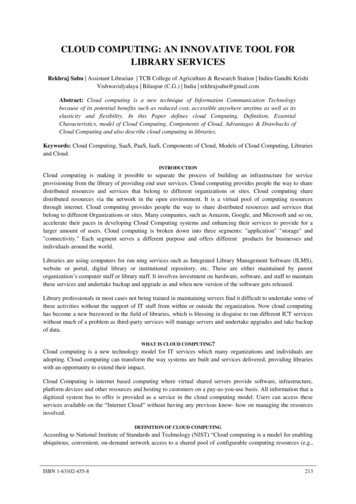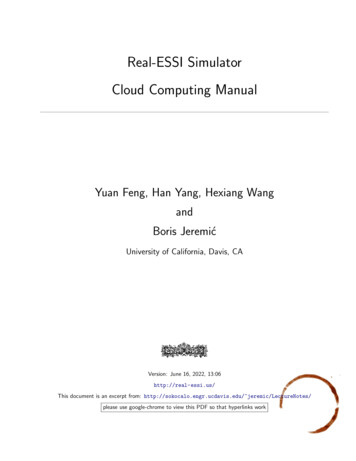
Transcription
CambridgeComputingThe First 75 YearsHaroon AhmedComputer Laboratory
CAMBRIDGECOMPUTINGThe First 75 Years
CAMBRIDGECOMPUTINGThe First 75 YearsHaroon Ahmed
2013 Cambridge Computer Laboratory andThird Millennium Publishing LtdFirst published in 2013 by Third Millennium Publishing Limited,a subsidiary of Third Millennium Information Limited2–5 Benjamin StreetLondonUKEC1M 5QLwww.tmiltd.comISBN 978 1 906507 83 1All rights reserved. No part of this publication may be reproduced ortransmitted in any form or by any means, electronic or mechanical,including photocopying, recording, or any storage or retrieval system,without permission in writing from the publisher.British Library Cataloguing in Publication Data: A CIP cataloguerecord for this book is available from the British Library.Written by Haroon AhmedPhotography by Alan DavidsonManaging Editor, Susan MillershipEditorial assistance by Neil BurkeyDesigned by Matthew WilsonProduction by Bonnie MurrayReprographics by Studio Fasoli, ItalyPrinted by Gorenjski Tisk, Slovenia
ContentsPrefaceForeword681Babbage’s ‘Magical Machines’102The Genesis of the Computer Laboratory203Maurice Wilkes: Computer Pioneer344Maurice Wilkes and the EDSACs445Maurice Wilkes: New Directions of Research and the End of an Era666Computing for All: Networking the University fromEDSAC Users to Desktops and Laptops – David Hartley847Spreading the Word: Teaching Computer Scienceand Technology – Peter Robinson948The Computer Laboratory, 1980–2012:The ‘Needham Years’ and the Modern Era1049Entrepreneurs, Spinning Out, Making Money andLinking with Industry12210 The Computer Laboratory on its 75th Birthday:A Centre of Research Excellence142BibliographyList of SubscribersIndexAcknowledgements and Picture Credits162166170176
PrefaceCambridge Computing is an illustrated historycelebrating the 75th anniversary of the foundation ofthe Computer Laboratory on 14 May 1937 and marks the100th anniversary of the birth of Professor Sir MauriceWilkes on 26 June 1913.Remarkably, the history of the Laboratory beganalmost a decade before the first modern electronic computerwas built. Professor Sir John Lennard-Jones, founderand first Director of the Mathematical Laboratory (nowComputer Laboratory) had the foresight to recognise thatnumerical methods would become increasingly importantin all branches of science, but the central figure of thiscommemorative book is Professor Sir Maurice Wilkes, whoreigned over the Laboratory for three and a half decades.In his obituary by the BBC, Wilkes was nominatedthe ‘Father of British Computing’, a perfect accolade for atrue computer pioneer, and three chapters here describe hisearly career, his work in the era of mainframe computersand his last 15 years of research before retirement. At theheart of the book is an account of the seminal achievementof the Laboratory, the construction and commissioningof EDSAC, the first stored-program digital computer tocome into regular service.Although this book is primarily about the ComputerLaboratory it does not ignore two great giants ofcomputing, Charles Babbage and Alan Turing, who wereboth Cambridge men. Babbage conceived mechanicaldigital computers with almost all the features of a modernstored-program computer nearly 100 years beforeelectronics made it feasible to build practical computers;while Alan Turing is, undoubtedly, the most famouscomputer scientist of all time and a national hero in theUK. Short accounts of the life and work of these two greatmen are included in the book.6
PrefaceThe early remit set by the University for theComputer Laboratory was to provide a computingservice to the University, and its history is outlined byDavid Hartley, the first Director of the ComputingService. Undergraduate teaching is an essential activityin any university and from its earliest days the ComputerLaboratory took this commitment to heart. PeterRobinson describes the evolution of Computer Scienceteaching in chapter seven.By 1980 computers had become ubiquitous andthe Computer Laboratory had to expand and moderniseits research to keep up with the extraordinary advancestaking place in computer science and technology. Its thirdDirector, Professor Roger Needham, led the Laboratoryfor 16 years into the modern era, and towards the end ofhis tenure he helped the University to secure a benefactionfrom the William Gates Foundation for a splendidnew building to house the Laboratory. Since then theLaboratory’s research has gone from strength to strengthand the last chapter of the book demonstrates the greatrange and depth of the current research programmes.Although teaching and research are the mainactivities in the Computer Laboratory it also pridesitself on the culture of entrepreneurship it instils intomany of those who graduate with a degree in ComputerScience. A chapter is devoted to the Laboratory’s formaland informal links with industry and to the spectacularlysuccessful business ventures of some of its alumni.Throughout the writing of the book it has been necessaryto balance the historical content against technological details.The choices have been difficult to make but in a book of 176pages with a large number of illustrations it was necessary torestrict technical details to the essentials.This book could not have been written without thesupport and cooperation of members of the Laboratorypast and present, and they are acknowledged at the endof the book. Documentary sources and the oral evidencefrom interviews are included in a bibliography.On a personal note, it was necessary to keep to strictdeadlines to ensure that the book could be published onthe 100th anniversary of the birth of Maurice Wilkes.Writing hours were long and interrupted only when KeirNizam, aged three, came to visit and demanded to playwith his grandfather, bringing a welcome respite. Andfinally, my wife Anne read all my first drafts and improvedthem immeasurably with her comments and corrections.Haroon AhmedJanuary 2013Professor Ahmed is Visiting Professor at the Computer Laboratory.7
ForewordCambridge Computing is more than just the story ofcomputing in Cambridge. Professor Haroon Ahmed setshis history in the broader framework of how calculatorsand computers evolved worldwide. He also describes howcomputer technology has been commercialised, using 12successful companies that have spun out of the CambridgeComputer Laboratory as examples, and provides anupdate on what is happening in computer research bydescribing current research in the Computer Laboratory.The first electronic computers were built to improveour ability to calculate, to outperform mechanicalcalculating machines. It was clear from the start thatelectronic switches, initially using radio valves, would befaster than mechanical mechanisms and that they could beused to build faster calculators, but no-one predicted thatthrough the use of semiconductor integrated circuits thesecalculators would become so powerful that they wouldimpact upon almost every aspect of human life: the waywe communicate, travel, entertain ourselves, grow food,design buildings, improve our health, and so on. Thereis little that computers have left untouched, and it seemsamazing that they did not exist 76 years ago. How to buildthe first machines, however, was anything but clear. It wasa daunting task, highly complex and filled with unknowns.Haroon Ahmed tells the story from the beginning,starting with mechanical calculating machines, andthen describing how Cambridge’s first stored-progamelectronic machine, EDSAC, was built by Maurice Wilkesand his team. He tells how others were making excellentprogress in the UK in Manchester, and that in the USAthey were operating on a much larger scale, but Wilkes’ssmall team kept up with the pace and was the first to usetheir computer in a routine manner to help scientists andengineers in their research.8Lord Broers was Vice-Chancellor of Cambridge University, 1996–2003.
The William GatesBuilding is the home ofthe Cambridge UniversityComputer Laboratory.Ahmed’s explanations of how these early machineswere built are clear and readily understood by non-experts.Occasionally he goes into a depth that may be difficultfor the layman but only when it is necessary to explainthe sequence of events, and even in these cases it doesn’tinterrupt the narrative. In the beginning the pioneersconcentrated on building machines. Their attentionthen shifted to the way the machines were used, and toeducating those who could benefit from them. The nextstep was to link machines together in rings and networksthereby connecting scientists and engineers, firstly indifferent laboratories in Cambridge, then around the UKand finally around the world. These ‘networks’ eventuallyled to the Internet.In the late 1960s it became apparent that there wasno point in universities continuing to build their owncomputers. The resources required to remain competitivebecame too great for universities, and users aroundthe world wanted to exchange their data and theirprograms and this required uniform standards. By thenthe computer industry was able to provide the resourcesand the standardisation and Cambridge along with otherleading universities purchased rather than built theircomputers. Similar situations have been reached in otherscience-based technologies and when this occurs futuresuccess depends on universities and industry workingclosely together. Cambridge excelled in its collaborationswith industry and has therefore remained among theworld leaders in computer research.Professor Ahmed carefully and completely describesthe evolution of computers going back and forth in timeas he alternates between describing technical progressand talking about those who made it happen. He hasproduced a volume that is a good read for anyone whowants to learn how things work in the 21st century, amust read for those who are working on the advancementof computers, and a valuable reference book for historiansof science and technology.Alec BroersDecember 20129
CHAPTER ONEBabbage’s ‘Magical Machines’soirÉes iN 19Th-ceNTury loNDoNCharles Babbage, Cambridge graduate and arguably the‘Father of the Computer’, invented mechanical ‘computing’machines. His Difference Engine No 1, Difference EngineNo 2 and Analytical Engine were all invented almost 100years before computers, using electronic devices, werebuilt at the end of the Second World War. Sadly, not oneof these three remarkable digital computers could be builtin his lifetime. Only a very small fraction of DifferenceEngine No 1, occasionally referred to as the ‘magicalcalculating machine’, was constructed and it operatedprimarily as a mechanical calculator. Despite Babbage’sdisappointment at the failure of his grand design, he usedthe small unit to good effect. He was a wealthy man whohad become something of a celebrity and he held soiréesat his home to which notables of the day were invitedto view demonstrations of the machine as part of theevening’s attractions.Following one of Babbage’s soirées (circa 1837), SirDavid Brewster wrote ‘that of all the machines whichhave been constructed in modern times, the calculatingmachine is doubtless the most extraordinary’. Brewsterhad watched a demonstration of the model DifferenceEngine in which the machine had calculated the numbersthat arose as the value of x was increased from zero to44 in the expression x2 x 41. Babbage fed the values ofx into the machine while a colleague noted down theanswers which appeared on dials at the machine’s output.The assembled company was amazed that the numberswere all correct! The speed of the calculating machine wasalso impressive. The human ‘printer’ was quite unable tokeep up with the machine when the numbers reached fivefigures. In the Victorian era Babbage was considered morea magician than a scientist.10At one of these soirées, guests included the 17-yearold Augusta Ada Byron, only legitimate daughter of thenotorious Lord Byron. Unusually for that period, Ada hadbeen well schooled in elementary mathematics and hadsufficient understanding of algebra to grasp the capabilitiesof the machine. She was enchanted by the animateddemonstration while Babbage was both surprised anddelighted by the knowledge of mathematics displayedby this charming young lady. Thus began an ambivalentfriendship lasting 20 years until Ada’s premature death atthe age of 37.Part of Charles Babbage’sDifference Engine No 1– a fine example ofVictorian mechanicalengineering. This smallpart was used by Babbagefor demonstrations. TheEngine was not completedbecause of manufacturingdifficulties anddisagreements betweenBabbage and his engineer,Joseph Clement.
Chapter One: Babbage’s ‘Magical Machines’Tables of numbers wereimportant in Babbage’stime and much useddespite doubts abouttheir accuracy. Babbage’sambition was to producetables free of all errors byusing calculating machinesinstead of ‘computers’.Ada married well and became Countess Lovelacein the fullness of time. The relationship that developedbetween her and Babbage was not without its problemsbut there is no doubt that at least some of Babbage’s famein his lifetime, and subsequently, rests on her efforts onhis behalf. She described and publicised the capabilitiesof Babbage’s machines in remarkably lucid prose and inso doing gained a unique place for herself in the worldof computing. She was not a great mathematician herselfbut through her association with Babbage, his constantguidance and her own perseverance and imaginativeinterpretations of his work, she staked a claim to beingthe very first computer programmer.Tables of N umbersTables of numbers mattered in the age of Queen Victoriawhen the British Empire encircled the globe. Industryand commerce were booming and maritime adventureswere taking British sailors across the oceans. Numericaldata were essential for enterprises to be successful andhuge tomes with tables of numbers were available forall sorts of purposes. There were tables of multiplicationand division, more advanced tables of logarithms andtrigonometric functions, financial tables for accountants,businessmen and bankers, actuarial tables for insurancecompanies, astronomical tables for travellers andnavigators and tables for construction engineers. Theproblem of the age was that these tables were not totallyaccurate and had to be used with caution. They weregenerated by mathematicians working with human‘computers’. The work was tedious and inherently subjectto human fallibility and serious errors could arise frommiscalculations, during the transcription of results and inthe typesetting for printing.The compilers were perfectly well aware that thenumber of errors could be reduced greatly by using teamsof ‘computers’ but this added to the expense of producingthe tables and there was even then no guarantee that errorswould be eliminated entirely. It was not just Babbagewho was aware of the problem; the government of theday was also concerned. It was common knowledge thatinaccuracies in tables could lead to harmful consequences.Babbage had convinced himself that errors could not beeliminated altogether as long as humans were involved inthe preparation of the tables. He is said to have declaredpublicly that only when a machine, or more dramatically‘steam’, could be used, not only to perform calculationsbut also to print the numbers, would all errors beeliminated. His purpose in building the difference enginewas partly to ensure the printing of accurate tables buthe believed also that the engine would be able to solvehitherto intractable mathematical problems. The scaleof his enterprise was immense but he was determinedto tackle it. The French government had paid a fortunefor the production of tables of logarithms printed in 17large folios. It had used teams of ‘computers’ whose workwas constantly cross-checked to minimise errors and thetables produced were believed to be the best available. TheBritish government wished to buy an abridged version ofthese tables in 1837 and offered the French 5,000 toparticipate in a collaborative project.Difference Engine No 1, the C alculatingMachineEarly in his life Babbage had come to the conclusion thatthe method of differences, the well-known mathematicaltechnique used to produce the tables by hand, could be11
Cambridge Computing: The First 75 YearsCHARLES BABBAGE (1791–1871)Victorian Polymath and ‘Father of the Computer’Charles Babbage was admitted to Trinity College in 1810to read Mathematics, but moved to Peterhouse beforegraduating. Increasingly dissatisfied with the low standard ofMathematics teaching, he and some of his friends urged theauthorities to make improvements, and later established theAnalytical Society for serious scholars of mathematics.Babbage married Georgina Whitmore in 1814 andsettled in London, where he became prominent as ascientist and gave lectures at the Royal Institution. He waselected a Fellow of the Royal Society in 1816 and becamea founding member of the Royal Astronomical Societyin 1820. He was also one of the founders of the BritishAssociation for the Advancement of Science, and in thecourse of his life published a number of books and papers,including his remarkable work On the Economy of Machineryand Manufactures. In 1828 Babbage was appointed LucasianProfessor of Mathematics at Cambridge University, a posthe held until 1839. This renowned Chair had previouslybeen held by Isaac Newton, and Babbage was flattered byhis own appointment. The duties of the post were light andBabbage was not required to live in Cambridge or to giveany lectures.In the course of his life Babbage became known assomething of an eccentric because he took up unusual causessuch as the suppression of street music and the banningof ‘calling shouts’ by street vendors. He also invented theophthalmoscope, although it was not taken up in his time,and both devised and broke cryptographic codes. Today heis recognised as a polymath who among his many and variedinterests created computers a century before they wereconstructed using electronics.Babbage died a sad and disillusioned man with hisgenius unrecognised and his computing machines incomplete.Posterity arguably sees him as the ‘Father of the Computer’,so far ahead of his time that it would take almost a centurybefore others could reach where he had already been. Todaythere are numerous memorials to his name scattered acrossthe world. In London the Science Museum is the repositoryof a great deal of material on Babbage and there areexcellent exhibits of his inventions.12implemented with machines. He had also realised that theresults could be transferred directly to another machinethat could print tables without any human intervention andhe argued that the outcome from a mechanical calculatoror ‘computer’ would be entirely free of errors. He proposedtherefore to build a ‘difference engine’ which would carryout all complex calculations using only addition. Todemonstrate the viability of his proposal he constructed aEngraving of Babbage atthe age of about 40, whenhe was in the prime of hislife and actively pursuingthe construction ofDifference Engine No 1.
Chapter One: Babbage’s ‘Magical Machines’Babbage graduated fromPeterhouse, the oldestcollege in Cambridge,founded 1284.small portion of the Difference Engine and described itsoperation to the Royal Astronomical Society in 1822 ina paper entitled ‘Note on the Application of Machineryto the Computation of Astronomical and MathematicalTables’. Babbage demonstrated that the machine could beused to calculate the members of a sequence of numbers butat this stage of the machine’s development its capacity waslimited and the numbers had to be noted down by hand.Babbage argued that a larger and more elaborateversion of his demonstration machine could not onlyprepare tables free of all errors more quickly than humancomputers, but also be very much cheaper to make anduse than the cost of employing teams of ‘computers’.The Royal Astronomical Society was impressed and notonly awarded Babbage a Gold Medal in recognitionof his achievement but also commended his ideas tothe government of the day. The Royal Society was alsopersuaded to support him. Having gained the support ofthe scientific establishment, Babbage’s proposal to build alarge difference engine was presented to the governmentand gained the approval of the then Chancellor of theExchequer. Public funds amounting to approximately 1,500 (over 150,000 today) were made available forthe project which Babbage undertook to complete in justthree years. Unfortunately both the cost and the timescalewere grossly underestimated.13
Cambridge Computing: The First 75 YearsAUGUSTA ADA BYRON, COUNTESS LOVELACE (1815–52)An Enigma in the History of ComputingIn one of his letters to her, Babbage referred to his friendand protégé, Ada, Countess Lovelace, as ‘The Enchantressof Numbers’. Their relationship is one of the more intriguingfeatures of Babbage’s intellectual life and his claim to fameas the pioneer of modern computing. She became deeplyinvolved with him from the moment of their first meetingwhen she was just 17.When Ada was 19 she married William King, who laterbecame the Earl of Lovelace. There followed the birth of threechildren, but when she was in her mid-20s, she returned toher interest in mathematics and particularly to her passion forBabbage’s engines. Throughout her years of marriage she hadkept up a correspondence with Babbage and was very awarethat he had moved on in his thinking, from the DifferenceEngine to designing the Analytical Engine.She studied carefully the concepts of the Analytical Engine,which had been explained to her in some detail by Babbage, anddeveloped a clear understanding of the working of the machineas one that could be instructed or ‘programmed’ to carryout problem-solving tasks without any intervention from theoperator other than inputting initial instructions.In 1843 she received an article on the Analytical Enginewritten by Luigi Menabrea, an Italian military engineer, basedon a presentation by Babbage in Italy. Ada translated the articlefrom French into English and wrote extensive appendices tothe article. These notes included a program in the form ofinstructions to the Analytical Engine in a logical set of steps bywhich a solution to a problem could be obtained.She likened the programmability of the machine to the wayAda Lovelace publicised Babbage’s work and with her writings earnedfor herself the title of the ‘First Computer Programmer’.in which a weaver made patterns in a loom, thus demonstratingclearly that she understood the need to follow a sequence ofinstructions’ in her appendices to Menabrea’s paper she issteps in strict order when instructing the machine. In her notesfrequently nominated the ‘First Computer Programmer’.she included several programs including one designed to calculateThere is no doubt that she wrote the appendices to thethe sequence of Bernoulli numbers. She also speculated on thetranslation of the paper by Menabrea and her name is the onlyidea that the machine might be useful for tasks other than theone attached to it. Moreover in her work she speculated thatnumerical work that had so preoccupied Babbage. She wrote thatcomputers would be able to do much more than Babbagethe engine might be able to compose music and that symbolshad envisaged. In her contributions to the paper by Menabrea,used in the machine might have a more general meaning thanthis gifted and passionate woman predicted applications thatjust numerical; today composers of modern music use computerscomputers would only be able to achieve a century and a halfextensively. Because Ada included examples of ‘problem-solvingafter her death.14
Chapter One: Babbage’s ‘Magical Machines’Babbage realised that the manufactured quality ofsome of the parts he needed for the Difference Engineexceeded state-of-the-art mechanical engineering in the19th century, and he therefore needed an outstandingengineer who could make technological advances in metalfabrication before designing and building some criticalparts. Following a recommendation from his friend andgreat Victorian engineer, Isambard Kingdom Brunel, hedecided to employ Joseph Clement, who was not only ahighly skilled toolmaker but also a draftsman with theskills necessary to translate Babbage’s ideas into workingdrawings. Clement had a nationwide reputation forproducing high-precision work but his quality came ata high price. He expected to be paid well for producingsuch excellence. Those who had employed Clement beforeBabbage knew that it was a case of caveat emptor if a firmprice was not agreed before he started work.As work progressed, Babbage and Clementwere faced with three problems for which Victorianengineering did not have ready answers. The first was theextremely high precision Babbage, perhaps unnecessarily,demanded for the parts. The second was the large numbersof identical parts needed for the engine in an age whenmass production methods were not commonplace. Thirdlyunusual shapes were required compared with the partsconventionally manufactured for Victorian machines.These problems could only be addressed by first makingadvances in machine tools, machining techniques andmass production methods. Clement had been given aconsiderable challenge by Babbage!Just as the work was gaining momentum it was delayedby the unexpected and untimely deaths of Babbage’s wife,his father, and two of his children. These were personaltragedies on such a scale that Babbage found it impossibleto work on his project for 18 months. Unfortunately, whenBabbage was able to resume work serious disagreementsarose between him and Clement on a number of issues.They were eventually resolved but work on the engine washalted for a year while negotiations took place; Babbagerealised that he needed more money and better premisesfor Clement if he were to complete his grand design.Perhaps only about half the requisite number of parts hadbeen fabricated after many years of effort and his fundsfrom the government were exhausted. Although he had avery considerable private fortune he did not feel justified inusing it to meet his costs. After all he was working for thepublic good and receiving no personal benefit. He madean application for increased funding which was supportedby the Royal Society and was granted considerable fundstowards acquiring new premises for Clement as well asfor the increased cost of building the engine. Babbagebelieved, perhaps now quite realistically, that he neededjust another three years to complete the task. Regrettablya disagreement with Clement arose over the move of hisworkshop to the site acquired by Babbage. The relationshipbetween Babbage and Clement completely collapsed.Clement fired his men and stopped all work and the projectto build Difference Engine No 1 was terminated. Babbagehad spent a great part of his life and as much as 17,000 ofpublic money, an enormous sum in 1840, on an enterprisethat had come to nothing. He was left with only a smallworking part of Difference Engine No 1 together with afeeling of immense frustration that a great opportunity hadbeen lost. For three decades he had dreamed of printingerror-free tables and he now faced the bleak prospect ofnever being able to realise his vision.C omputer P ioneerBabbage is widely recognised as the first computer pioneer,not so much for his work on the Difference Engine butbecause of his work on his Analytical Engine, although ittoo was never built. His claim rests on theoretical work,notes, drawings and designs which have gradually cometo light over the years, and on a very small fraction ofthe machine which was completed just before his death.These documents and objects have established his primacyin conceiving, in the middle of the 19th century, manyfeatures that are incorporated in the 21st-century generalpurpose computer built with electronic devices.His concepts and designs were so far ahead of thecontemporary developments that they were forgotten – orperhaps more to the point, they were not understood. Hiswork was neither used nor referenced when computersbased on electronic devices were developed at the end of theSecond World War. The gap in time between the conceptof the Analytical Engine and the modern computer wasa discontinuity of 100 years, and in this lapse of time allrecords could well have been lost. Fortunately almost all his15
Cambridge Computing: The First 75 YearsJOSEPH CLEMENT (1779–1844)A Forgotten Victorian EngineerJoseph Clement was one of the outstanding mechanicalengineers of the Victorian era. He was a craftsman who couldproduce work of exceptional quality and a designer anddraughtsman who could translate the ideas of his customersinto accurate and comprehensive working drawings.Clement was the son of a weaver and received onlyelementary schooling. His father taught him the rudiments ofmechanical engineering and he acquired various other skills inthe course of his many different employments as a young man.He moved to London and gained employment as a worksmanager and later as a draughtsman. Having saved a little moneyand gained in both skills and confidence he set up his ownworks which specialised in high-quality mechanical engineeringand draughtsmanship. Some of the great Victorian engineersused his services, and among them was Brunel. Clement wonthe gold medal of the Society for the Encouragement of Artsfor his tools, which included a very high-precision lathe witha self-adjusting chuck. He also made a planing machine whichwas unique in the range of mechanical tasks it could carry out.He pioneered the ideas of standardisation in mechanical partssuch as screw threads. After falling out with Babbage, Clementcontinued working and made a good living until he retired totake up his old hobby of making musical instruments. He diedleaving a considerable estate.work was preserved by his family for posterity to re-examineand
commemorative book is Professor Sir Maurice Wilkes, who reigned over the Laboratory for three and a half decades. In his obituary by the BBC, Wilkes was nominated the 'Father of British Computing', a perfect accolade for a true computer pioneer, and three chapters here describe his early career, his work in the era of mainframe computers











